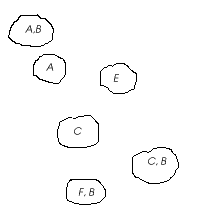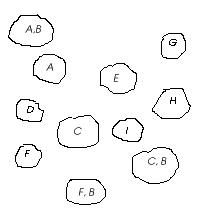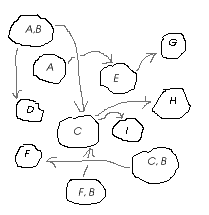


ABThing(A,B,
AThing(A,
EThing(E,
CThing(C,
FBThing(F,B,
CBThing(C,B,
ABThing(A,B,D,C)
AThing(A,E)
EThing(E,G)
CThing(C,I,H)
FBThing(F,B,C)
CBThing(C,B,F)
ABThing(A,B,D,C)
AThing(A,E)
EThing(E,G)
CThing(C,I,H)
FBThing(F,B,C)
Given a set of functional dependencies like the following...



ABThing(A,B,
AThing(A,
EThing(E,
CThing(C,
FBThing(F,B,
CBThing(C,B,
ABThing(A,B,D,C)
AThing(A,E)
EThing(E,G)
CThing(C,I,H)
FBThing(F,B,C)
CBThing(C,B,F)
ABThing(A,B,D,C)
AThing(A,E)
EThing(E,G)
CThing(C,I,H)
FBThing(F,B,C)
Not long after I put this page on the Web, I was shown some comments[Note1] and discussion on the methodology by C. J. Date, Hugh Darwen, David Miles, Kevin Waugh, and others. Based on these comments, it exhibits at least the following limitations:
Futhermore, the diagramming style was claimed[Waugh3] to be similar to one employed in Date's text, "An Introduction to Database Systems".[Date2] While it turns out this doesn't necessarily affect the methodology (other than justifying alterations to match a more familiar model), and it may be a useful learning tool, I do question its overall usefulness in actual practice.[Note2].
Recently, I resumed interest in the idea -- a side effect of a growing interest in software (particularily database) visualisation. As time permits, I'll work on verifying and addressing the limitations, and review algorithms such as reference [Date3] for converting a set of FDs into 3NF (but not BCNF) relations. This may lead to an improved diagramming methodology and/or a means of visualising existing or new normalisation algorithms. Suggestions or comments are welcome.
[Note1] These were published on an email mailing list open to tutors and lecturers on a given university Database course. Out of respect for their privacy and copyright, I shall not reprint their comments or identify the university or the mailing list until I have obtained written permission to do so.
[Waugh1] Waugh, Kevin. Email to mailing list. (September 11, 2000 2:35 PM)
[Waugh2] Waugh, Kevin. Email to mailing list. (September 11, 2000 3:11 PM)
[Date1] Date, C. J. "A Response to Dave's Quick-But-Unproven Normalisation Method", Fax image of printed text attached to email to mailing list, forwarded by Hugh Darwen. (September 12, 2000.)
[Waugh3] Waugh, Kevin. Email to mailing list. (Thursday, September 07, 2000 10:14 AM)
[Note2] As more of a practitioner than a theoretician, I'd always treated normalisation as a means to an end rather than an object of study, so I was quite happy to normalise using conventional methods. Business models (or at least the ones I typically dealt with) tended to generalise to a limited set of common generic models (eg., Accounts Receivable, General Ledger, Inventory, etc.) -- each normalised once, reused frequently, coupled and decoupled easily, and altered rarely (with renormalisation as needed) to meet specific user requirements.
[Date2] Date, C. J. "An Introduction to Database Systems. Sixth Edition.", Addison Wesley Publishing Company, Inc. (1995)
END